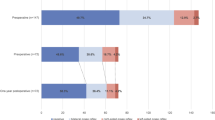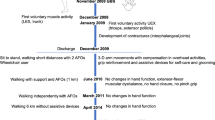Abstract.
A male infant with congenital hydrocephalus who had undergone ventriculoperitoneal (VP) shunting at 3 days of life exhibited a diminished plantar grasp response (PGR) from 2 months of age, which had clearly recovered 3 months after a shunt revision at 6 months of age. The diminished PGR was the only overt neurological sign in this patient. The precipitous decrease in PGR that occurs during early infancy in a hydrocephalic infant with VP shunting is a possible indicator of a prespastic condition caused by a shunt malfunction.
Similar content being viewed by others
Author information
Authors and Affiliations
Additional information
Electronic Publication
Rights and permissions
About this article
Cite this article
, ., , . Diminished plantar grasp response as an additional indicator of a shunt malfunction in a case of congenital hydrocephalus. Child's Nerv Syst 17, 415–418 (2001). https://doi.org/10.1007/s003810100452
Received:
Revised:
Issue Date:
DOI: https://doi.org/10.1007/s003810100452




